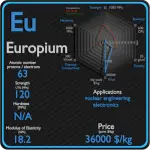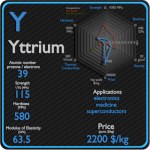This article contains comparison of key thermal and atomic properties of holmium and ytterbium, two comparable chemical elements from the periodic table. It also contains basic descriptions and applications of both elements. Holmium vs Ytterbium.

Holmium and Ytterbium – About Elements


Source: www.luciteria.com
Holmium and Ytterbium – Applications
Holmium
Holmium has the highest magnetic strength of any element, and therefore is used to create the strongest artificially generated magnetic fields. Holmium can absorb neutrons, so it is used in nuclear reactors to keep a chain reaction under control. Its alloys are used in some magnets.
Ytterbium
Ytterbium is beginning to find a variety of uses, such as in memory devices and tuneable lasers. It can also be used as an industrial catalyst and is increasingly being used to replace other catalysts considered to be too toxic and polluting. A small amount of ytterbium is used to add strength to specific steel types. Ytterbium can also be used as a dopant to help improve the grain refinement, strength, and other mechanical properties of stainless steel.
Holmium and Ytterbium – Comparison in Table
| Element | Holmium | Ytterbium |
| Density | 8.795 g/cm3 | 6.57 g/cm3 |
| Ultimate Tensile Strength | 260 MPa | 69 MPa |
| Yield Strength | 220 MPa | 66 MPa |
| Young’s Modulus of Elasticity | 64.8 GPa | 23.9 GPa |
| Mohs Scale | N/A | N/A |
| Brinell Hardness | 750 MPa | 340 MPa |
| Vickers Hardness | 490 MPa | 210 MPa |
| Melting Point | 1474 °C | 819 °C |
| Boiling Point | 2600 °C | 1196 °C |
| Thermal Conductivity | 16 W/mK | 39 W/mK |
| Thermal Expansion Coefficient | 11.2 µm/mK | 26.3 µm/mK |
| Specific Heat | 0.16 J/g K | 0.15 J/g K |
| Heat of Fusion | 12.2 kJ/mol | 7.66 kJ/mol |
| Heat of Vaporization | 241 kJ/mol | 128.9 kJ/mol |


